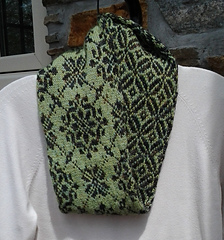patterns >  Renee Burton's Ravelry Store
Renee Burton's Ravelry Store
> Latvian Loop











Latvian Loop
This is a two-sided stranded cowl incorporating traditional Latvian motifs. It can be worn in multiple ways, making it seem like several different cowls. This can be knit by holding multiple strands of a lace weight yarn together, or using up to a fingering weight yarn alone.
The design uses a motif with a large repeat on one side, and a small repeat on the other side, and reverses the background colours between sides. This gives a shadowed look, with varying complexity, to the loop. The cowl is knit in the round as a long tube, and then kitchener stitch is used to create a final seam. As an easier alternative to the recommended stranded kitchener stitch, a single colour kitchener can be used.
The large motif has long floats, however, knitters who are less experienced with stranded knitting can create a striking loop using only the smaller motif and reversing the colours on each side.
The design is part of ColourMartian Designs 2014, a collection of designs that highlight ColourMart yarns by members of the Ravelry ColourMart Lovers Group. This particular design is intended to demonstrate how knitters can combine lightweight ColourMart yarns effectively for heavier weight items. Notably, three or four strands of a laceweight yarn can be held together to create a marled yarn, offsetting either a contrasting marl combination or a solid colour. One could also exchange the multiple strands of laceweight for a slightly heavier yarn held singly. While designed with ColourMart yarns in mind, one can, of course, use other yarns of a similar weight and gauge. This design was tested both with ColourMart and several other brands of yarn.
Skills Required:
- Stranded knitting in the round. The large motif contains long floats, however the smaller motif can be used for both sides of the cowl.
- provisional cast on
- stranded graft or kitchener stitch. The stranded graft is a stranded variation of the standard graft. Instructions are included for this uncommon technique and knitters may also elect to use a single colour graft.
A note on the stranded graft The finish used in this design is definitely an advanced technique, and can be quite frustrating to even great knitters. Here’s a couple of tips to help, beyond the instructions included in the pattern.
- First, you really do not need to do the stranded graft. Honest. If you look at other stranded loops on Ravelry, you’ll find most/all use a single colour graft.. this will create a line but using the background colour on each side, respectively, will minimize the visibility.
- No matter what graft you use, you might want to run dental floss through both sets of loops before you begin. This will help you keep the loops if you need to pull some graft out, and it’s easy to remove at the end.
- Practice first. The technique isn’t hard once you “get it”, but it is a brain challenge at first. One way to get your head around it is to create a swatch (can be single colour stst) and then practice the stranded graft to bring the two ends together. this could be a tube or flat piece.
- pour a glass of wine and find a relaxing time to begin.
102161 projects
stashed
152274 times
4539 projects
stashed
5073 times
1179 projects
stashed
1321 times
3008 projects
stashed
3793 times
532 projects
stashed
731 times
767 projects
stashed
1132 times
- First published: May 2014
- Page created: May 28, 2014
- Last updated: October 18, 2019 …
- visits in the last 24 hours
- visitors right now




